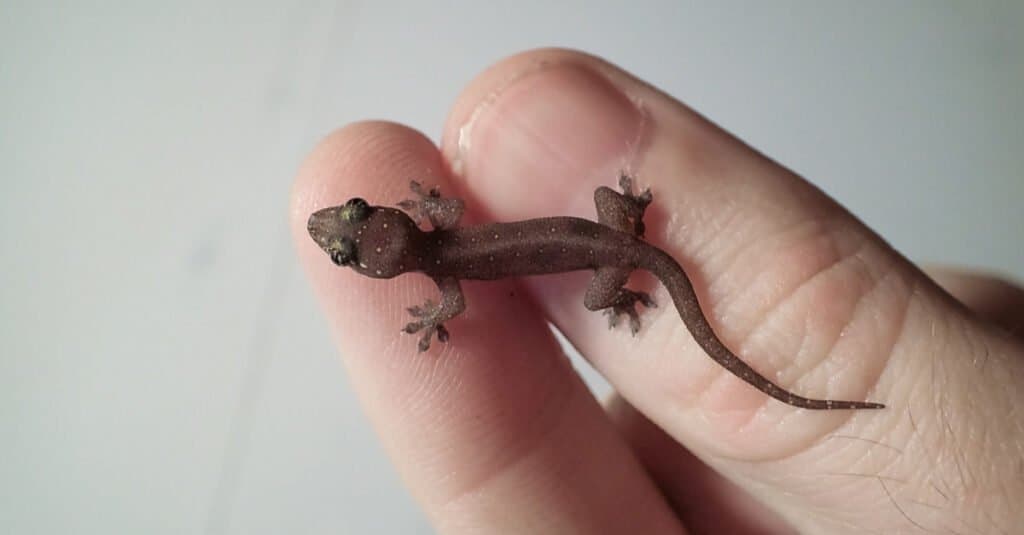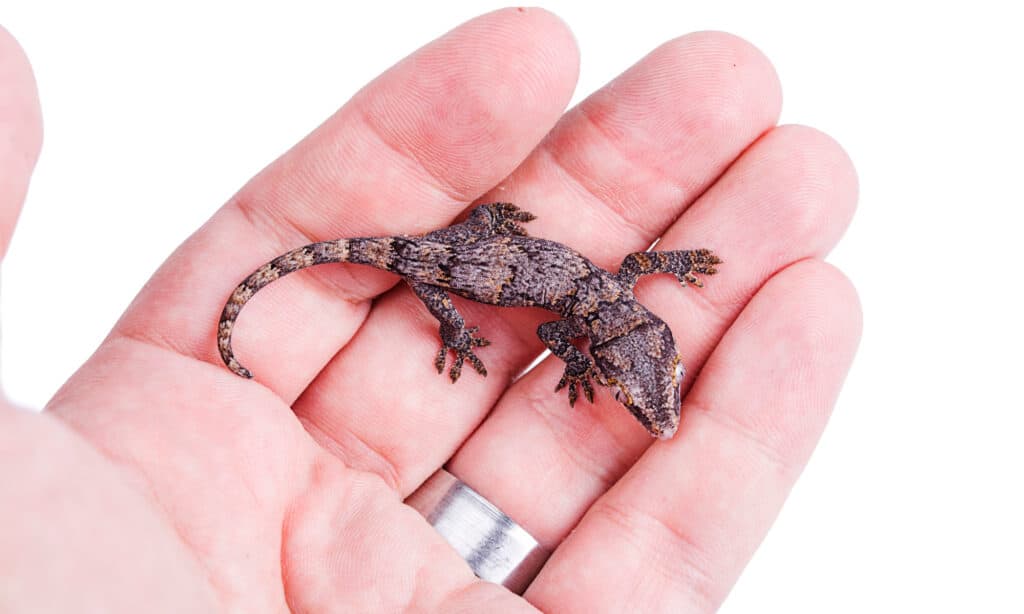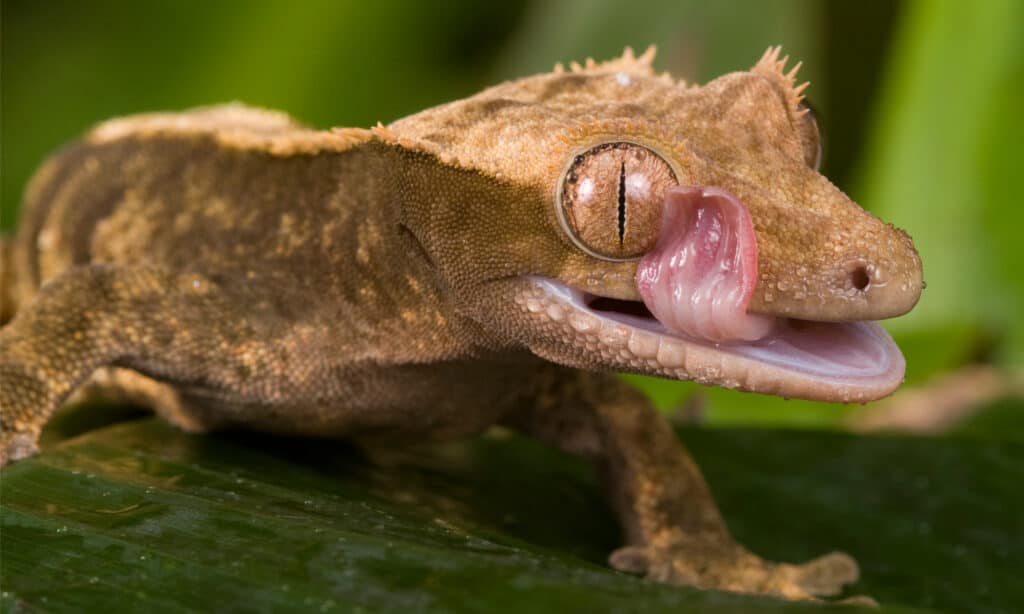Baby geckos are adorable and fascinating little creatures that live on every continent except for Antarctica. Ranging in size from a mere half an inch to almost 24 inches long, baby geckos come in a stunning array of colors and patterns. Let’s take a look at some delightful pictures and amazing facts about baby geckos!
1. There Are More than 1,500 Different Types of Gecko Babies

Common house geckos only grow about 3 to 6 inches when they are full-grown.
©N8Allen/Shutterstock.com
Geckos make up about 14% of all reptile species, with 1,500 different gecko species found all over the world! These amazing creatures have been around since the time of the dinosaurs, during the Jurassic period. Geckos are closely related to other lizards and snakes, but they also have their own unique features.
The largest gecko species ever recorded is Gigarcanum delcourti, a gecko that measured almost 24 inches long! However, scientists only have one example of this gecko, as it likely went extinct in the nineteenth century. Today, the largest living gecko is the New Caledonian giant gecko (Rhacodactylus leachianus), which can grow 14 to 17 inches long. The smallest gecko is the Jaragua dwarf gecko (Sphaerodactylus ariasae), which measures just 0.5 to 0.7 inches long. Just imagine how tiny a baby Jaragua gecko would be!
2. Sometimes Temperature Decides if Baby Geckos Are Male or Female

Tokay geckos are one of the largest types of geckos, growing 10 to 12 inches on average.
©lessysebastian/Shutterstock.com
Each gecko species has its own way of determining the gender of baby geckos, often through genes or environmental influences. For many baby geckos, temperature plays a big role in determining their gender. This is called Temperature-Dependent Sex Determination (TSD), and it is seen in many species like the African fat-tailed gecko (Hemitheconyx caudicinctus) and the leopard gecko (Eublepharis macularius).
Female geckos of these species bury their eggs in sand or loose soil and abandon them. The temperature surrounding the eggs helps to incubate them and influences whether the babies inside will develop into male or female babies. In leopard geckos, for example, cooler temperatures and extra warm temperatures typically produce female babies, while temperatures in the middle produce male babies.
3. Baby Geckos Have Amazing Night Vision

Gargoyle geckos only live in New Caledonia.
©iStock.com/reptiles4all
Most geckos are nocturnal, which means they are active at night. Unlike most other lizards, geckos also have amazing night vision, which means they can see super well in the dark. In fact, in low light conditions, gecko eyes are 350 times more sensitive to light than human eyes!
Geckos have different types of cones in their eyes and three different types of photo-pigments that help them see blue, green, and ultraviolet colors. In addition, they also have a unique optical system that allows them to see things clearly at different depths. In other words, geckos can focus on far away objects as well as objects that are close to them.
4. Some Baby Geckos Have Sticky Toes

Geckos have millions of microscopic setae on the bottom of their feet.
©Lauren Suryanata/Shutterstock.com
Many baby geckos are incredible climbers due to the expanded digital pads, also known as scansors or scansor pads, on the bottom of their toes and feet. These pads are lined with rows lamallae, which are like little grooves. The lamellae are covered with microscopic hair-like structures called setae. These can adhere to smooth surfaces using the van der Waals force, which allows them to effortlessly grip and climb up smooth vertical surfaces.
In many areas around the world, geckos are common household guests, climbing up walls, windows, and even ceilings as they help to control pests within the home. What’s even more incredible, however, is that some geckos can even hang on by just one of their sticky toes, while others can withstand wind speeds up to 60 miles an hour!
However, it is important to note that not all baby geckos have sticky toes. Leopard geckos, for example, are desert animals. They have claws to help them dig in the sand instead of adhesive toes.
5. Baby Geckos Can Lose and Regrow Their Tails

Day geckos are delicate creatures and should not be handled, as they drop their tails readily.
©David Pegzlz/Shutterstock.com
When a baby gecko senses direct danger, it can purposely snap its tail off! Known as caudal autonomy, the detached tail can continue twitching for up to 30 minutes, creating a clever distraction that makes the predator focus on the tail rather than the gecko itself. This buys valuable time for the baby gecko to make its getaway.
Contrary to popular belief, however, a gecko’s severed tail doesn’t just twitch back and forth — it can also jump, flip, and lunge in many complicated patterns. In fact, a detached lizard tail can even perform acrobatic flips over an inch off the ground! It may take a long time, but eventually, the gecko will regrow a new tail to replace the one it chose to sacrifice.
6. Baby Geckos Care For Themselves

Crested geckos are sometimes called eyelash geckos.
©Bella Corchis/Shutterstock.com
Although they are very small when they hatch, baby geckos have developed bodies. In other words, baby geckos are more like miniature adult geckos than helpless newborns. Their parents don’t stick around to raise them, so as soon as they hatch, they are on their own.
Baby geckos eat the same types of food as adult geckos, although in much smaller doses and sizes. Baby geckos are either omnivores or strictly carnivores. They eat small insects like mealworms, superworms, crickets, spiders, and small grasshoppers. As they grow and get bigger, they can capture larger prey.
7. Many Baby Gecko Species Can Be Wonderful Pets

Gargoyle geckos have unique prehensile tails that allow them to grip vines and branches.
©iStock.com/Kaan Sezer
There are many types of baby geckos that can make wonderful pets. Crested geckos (Correlophus ciliatus) have beautiful, big eyes with delicate eyelashes, while leopard geckos and African fat-tailed geckos sport bold and colorful patterns. Unlike other species, day geckos (PhelsumaI) are active during the day. However, they are not a good choice for first-time owners, as they are very fragile. Tokay geckos (Gekko gecko) are less common pets and best for advanced reptile enthusiasts. They are larger geckos with beautiful, blue-gray bodies and bright blue and orange spots.
Pet baby geckos tend to be calm and peaceful, although they do have their own preferences and behaviors. For example, if you have more than one gecko, you should never put two males together, as this will lead to aggression.
8. Most Baby Geckos Don’t Have Eyelids

Since they don’t have eyelids, geckos lick their eyes to keep them moist.
©iStock.com/Stuartb
Unlike many other animals, most baby geckos don’t have any eyelids! Instead, they have what’s called a “brille”. This is a transparent membrane that covers the outer surface of their eyeballs. However, there is one exception to this rule: baby geckos in the Eublepharidae family actually do have eyelids! For example, African fat-tailed geckos and leopard geckos both have eyelids.
But how do geckos without eyelids protect their eyes or keep them clean? These geckos have a fixed lens within each iris that functions almost like built-in sunglasses. It can enlarge in the dark to allow more light to enter their eyes or shrink to protect the gecko’s eye from bright sunlight. In addition, geckos can’t blink, so they keep their eyeballs clean with their tongues! Baby geckos use their tongues to lick their eyeballs, removing any dust or debris that may be there.
The photo featured at the top of this post is © Bella Corchis/Shutterstock.com
Thank you for reading! Have some feedback for us? Contact the AZ Animals editorial team.






